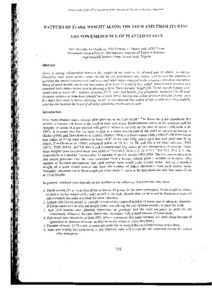| dc.contributor.author | Akoroda, M.O. |
| dc.contributor.author | Oyadiran, T.F. |
| dc.contributor.author | Yomeni, M.O. |
| dc.contributor.author | Okoro, E. |
| dc.contributor.author | Dixon, A. |
| dc.date.accessioned | 2019-12-04T11:15:39Z |
| dc.date.available | 2019-12-04T11:15:39Z |
| dc.date.issued | 2006 |
| dc.identifier.citation | Akoroda, M., Oyadiran, T.F., Yomeni, M.O., Okoro, E. & Dixon, A. (2006). Pattern of stake weight along the stem axis from its base and non emergence of planted stakes: Repositioning agriculture for sustainable millennium development goals in Nigeria. Proceedings of the 40th annual conference of the Agricultural Society of Nigeria (p. 758-763), 16-20 October, Umudike: Agricultural Society of Nigeria. |
| dc.identifier.uri | https://hdl.handle.net/20.500.12478/3007 |
| dc.description.abstract | There is strong relationship between the weight of stake to be planted and it ability to emerge. Therefore, only good quality stem should be cut, partitioned into stakes, and treated for planting to optimise the limited resource of land area and other input engaged in the cassava cultivation enterprise. Stems of good health can cut into stake of at least 50gm, and if they satisfy severe other features of a standard stake before being used in planting a field. These includes: length (20-25cm), age (6-9map). Pitwood ratio at least 50% number of nodes, sane and healthy, (no symptoms), diameter (20-30mm), diameter relative to stem base ( should be atleast 50%), having one colour of outer skin (no green), cut a few days (less than 5) before planting. In all, we recommend that stake of any weight over 50g could be used but the heavier the better if all other standard criteria are present. |
| dc.language.iso | en |
| dc.subject | Stems |
| dc.subject | Stakes |
| dc.subject | Cassava |
| dc.subject | Genotypes |
| dc.subject | Cultivation |
| dc.subject | Nodes |
| dc.title | Pattern of stake weight along the stem axis from its base and non emergence of planted stakes |
| dc.type | Conference Paper |
| dc.description.version | Peer Review |
| cg.contributor.affiliation | International Institute of Tropical Agriculture |
| cg.contributor.affiliation | High Rainfall Station |
| cg.coverage.region | Africa |
| cg.coverage.region | West Africa |
| cg.coverage.country | Nigeria |
| cg.authorship.types | CGIAR and developing country institute |
| cg.iitasubject | Cassava |
| cg.iitasubject | Markets |
| cg.iitasubject | Plant Production |
| cg.iitasubject | Plant Genetic Resources |
| cg.iitasubject | Plant Diseases |
| cg.iitasubject | Farm Management |
| cg.iitasubject | Pests Of Plants |
| cg.iitasubject | Agribusiness |
| cg.iitasubject | Genetic Improvement |
| cg.iitasubject | Post-Harvesting Technology |
| cg.iitasubject | Livelihoods |
| cg.iitasubject | Smallholder Farmers |
| cg.iitasubject | Handling, Transport, Storage And Protection Of Agricultural Products |
| cg.iitasubject | Plant Breeding |
| cg.iitasubject | Food Security |
| cg.accessibilitystatus | Limited Access |
| local.dspaceid | 94473 |

